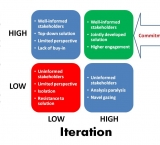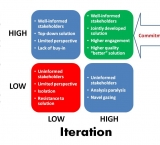Story:
Commiterate to solve dilemmas
As the new Director of the Gardiner Centre, I felt compelled to sit in on a training course to get a full taste of the “Gardiner experience”. I decided to take in one of the courses offered in partnership with Schulich School of Business at York University and something that could help me in the challenges of taking on my new role – Critical Thinking.
As the class began, the instructor, Alex Lowy – an accomplished author and strategist – asked each of us to write on our tent cards a nickname which we would use to describe our style of dealing with issues. After a few moments of self-examination, I coined my nickname – the commiterator. In deference to the Governor of California’s series of movie roles, I meant no resemblance to the Terminator.
What is commiteration? It began in my mind as the contraction of two words that describe my approach: communication and iteration. After further thought and discussion, a third word representing the outcome of that approach became obvious – commit. Alex encouraged me to write about the concept and how I use it. So, here it is…
When I am faced with difficult situations, I believe engaging as many inputs as possible enables arriving at the best answers while also enabling commitment to the process and the resultant resolution. Obviously, the amount of time one has available to resolve the issue they face will impact the breadth and depth of communications and the number of iterations. The more time you have, the lengthier and more in-depth the communications and the more iterations you can go through.
So, at the outset, I communicate. I share with people (especially stakeholders and as many of them as possible) what my perception and definition of the issue is. I engage people either in groups or individually. I ask them to confirm or enhance the framing of the issue. I encourage them to challenge assumptions and share their descriptions and modifications. It is a dialogue.
I keep in mind one important caution - don’t jump to conclusions or solutions - try to let it rest and give it time “to percolate”. I continue to consult and dig deeper on the potential elements of the issue. I explore whether the issue can be sub-divided or broken down to help focus the dialogue. Taking these more focused elements, I iterate with small groups or with individual contributors. When the discussions have run their course and the elements of the issue are more clearly understood, I consolidate the various elements into a holistic view.
In the next stage of iteration, I share potential solutions with various stakeholder individuals and with small groups. I encourage the participants to take the solutions discussion to the anticipated outcomes and then work backwards to define the specific activities and steps needed to reach the outcome. I try and engage them in further refining activities. Finally, I bring a larger group together to share progress and seek additional opinion and input as to the acceptance and feasibility of the solutions and related actions.
Over the time that this process takes, the various people I have involved will begin to speak a common language about the issue. They develop a common understanding of the elements of the issue and the potential solutions and courses of action. Often, a preferred course of action emerges that the group can live with or may even strongly endorse. They become committed to the resolution and the actions to be taken. They have committed through the process of commiteration.
Commiteration does not always go through every step – time and resources sometimes constrain the complete use of the process. As well, resolution does not always emerge nor, in some cases, does agreement on the actions to take. Commiteration is not a panacea. However, it can help progress in terms of defining the issue, understanding various elements and identifying potential solutions. And, it has worked for me.
When I first arrived at the Gardiner Centre our spring schedule was riddled with cancelled courses. After some initial analysis, I began to work with the individuals involved (training advisor, program developer, financial person and delivery peple) to understand their perspectives on why the cancellations were happening. I met with them one-on-one and jointly. I heard a number of varying opinions on why the problem was occurring. With the input information gathered I met with the group to outline my understanding of the situation. We then went our separate ways to consider what might solve the problem and applied our thinking to the development of the fall schedule. We held a number of meetings where we debated what courses should be offered, which should be dropped, which continued and which new courses to add. We assigned small groups to discuss what target markets should be approached for each course and how best to approach them (advertising, emails campaign telephone calls, etc.). We also outlined a plan of attack for marketing and sales. The plan was briken down into monthly campaigns and focused on the target groups for each course for that month with individuals assigned duties following regular iterative meetings on what best to do.
As a result, we had no cancelled courses in the fall trimester. Also, we doubled out paid seats in the open enrolment area on a year over year basis. And all this happened during the economic downturn resulting from the financial crisis.
Brian:
Suggestion regarding the graphic. I have a feeling the solution generated would make a fourth bullet point in the upper right quadrant:
* Higher-quality "better" solution (than what would have come out of any of the other corners).
- Log in to post comments
Thanks Eric and Polly,
This blog and comment style forum is the very essence of commiteration at work. I have tried to incorporate improvement in the story based on your comments.
Much appreciated,
Brian
- Log in to post comments
Brian (or should I say The Commiterator?), thanks for your great story. Your approach to tackling problems and testing ideas is not only practical and methodical, but open-minded and mindful in ways that strategy-setting generally isn't. I have two thoughts:
1) it would be great if you could add an illustrative anecdote to your write-up: what's a real-world context in which you used this process, did it go perfectly smoothly, did you bump into any challenges (and how did you address them), what did you learn and tweak in the process, and how did this change the working life of the people around you?
2) this could be a fantastic hack: a challenging vision to the community to re-imagine the process of strategy-setting and problem-solving in a much more open, emergent way
Thanks!!
- Log in to post comments
Hi Brian:
Excellent story. You have woven all the critical pieces of effective strategy together--decision-making, information management, individual and group discussion, reflection, and drilling down to utilize business model drivers.....
Eric Schillinger
- Log in to post comments









You need to register in order to submit a comment.